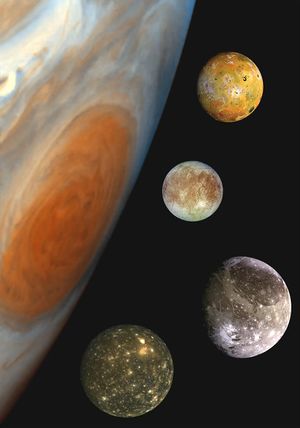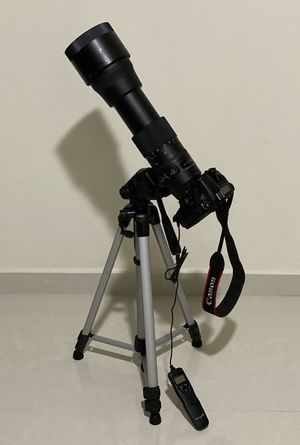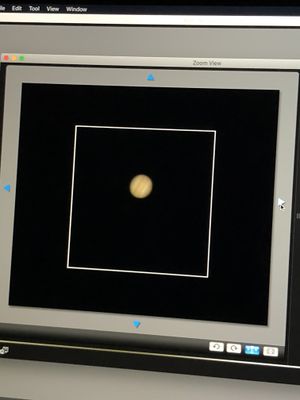Orbits of the Galilean Moons

Galileo Galilei’s discovery of celestial bodies that orbit something other than the Earth marked the beginning of the end of the geocentric model of the universe. In this project, we will perform the same observations on those moons as Galileo did 400 years ago.
Team Members
- A0168128Y Matthew Wee
Objectives
- To observe the planet Jupiter and its four largest moons—Io, Europa, Ganymede, and Callisto
- To measure the orbital parameters of those four moons
- To explore the orbital resonances of the inner three of those moons—Io, Europa, and Ganymede
- To verify Kepler’s Third Law
- To assess the viability of consumer equipment in performing precise scientific measurements
History

Jupiter is a planet that was known to the ancients as it is the fourth brightest object in the sky behind the Sun, the Moon and Venus, and is visible to the naked eye. In 1609, astronomer Galileo Galilei made improvements to his telescope, which was the best in the world at the time. With the telescope, over the course of several weeks, he observed four “stars” moving in a line around Jupiter and was persuaded after just four days of observations that they were not stationary stars but instead objects orbiting the planet Jupiter.
This discovery, along with several others, was the cornerstone of the Copernican Revolution, which was the transition from the geocentric to the heliocentric model, with the Sun instead of the Earth at the center of the universe.
Since then, astronomers have discovered a total of 80 moons that orbit Jupiter, 23 of which have no official names.
Background
The four Galilean moons, in increasing order of orbital radius, are Io, Europa, Ganymede, and Callisto, of which, Io, Callisto, and Ganymede are larger than the Earth's Moon in both mass and diameter. Ganymede is even larger than the planet Mercury. Because of their size, they can be observed from Earth with a small telescope or even a pair of powerful binoculars.
The main challenge faced when trying to observe these moons is the sheer brightness of Jupiter relative to the dim moons, and their small angular separation from Jupiter. This is especially true for the innermost moons Io and Europa.
Apparatus

No specialized equipment was used in this experiment to make observations of the planet and its moons.
- Canon EOS 60D DSLR
- APS-C sensor (1.6× crop)
- Sigma 150–600mm f/5–6.3
- Lens diameter 95mm
- Field of view: 16.4º–4.1º (effective 10.2º–2.6º)
- Low-end consumer tripod
- Spirit level
- Remote shutter
Exposure Settings
- Manual
- Focal length: 600mm (effective 960mm)
- 1/15s exposure
- f/6.3 aperture
- ISO 3200 sensitivity
- Manual focus
- Image stabilization off
The exposure time cannot be set too long as motion blur due to the Earth's rotation will be visible in the image.
Data
Procedure

A series of observations were performed with the telephoto lens mounted on the camera. Weather permitting, exposures were taken every day within an hour of sunset for two and a half calendar weeks from 31 January 2022 to 17 February 2022.
At the time of these observations, Earth's motion around the Sun (and to a lesser extent, Jupiter's as well) caused the apparent position of Jupiter in the sky to drift closer to the sun every day, forcing observations to occur closer and closer to sunset. The last observation on 17 February was taken at 7:59 PM, when the sun had barely set and the sky was still relatively bright. It was decided that no more observations could be taken thereafter.
By inspecting the moons and their positions relative to Jupiter in the captured images, their apparent angular separation can be determined for every observation. The data are presented in the table below.
Raw Data
| Observation | Angular distance between moon and center of Jupiter (arbitrary units) | |||
|---|---|---|---|---|
| Io | Europa | Ganymede | Callisto | |
| 2022-01-31 | 68.9 | occultation | 102.7 | -254.2 |
| 2022-02-01 | -32.2 | 155.4 | 245.7 | -371.0 |
| 2022-02-02 | no data collected | |||
| 2022-02-03 | 50.6 | -127.9 | 23.8 | -437.9 |
| 2022-02-04 | -76.3 | 113.8 | -175.9 | -392.3 |
| 2022-02-05 | 96.4 | 83.2 | -251.8 | -284.4 |
| 2022-02-06 | no data collected | |||
| 2022-02-07 | 86.2 | -31.0 | 62.2 | 25.5 |
| 2022-02-08 | -55.7 | 154.5 | 224.8 | 183.0 |
| 2022-02-09 | no data collected | |||
| 2022-02-10 | occultation | -145.8 | 68.0 | 405.6 |
| 2022-02-11 | -52.4 | 87.2 | -140.1 | 437.5 |
| 2022-02-12 | 81.0 | 108.1 | -246.5 | 408.5 |
| 2022-02-13 | no data collected | |||
| 2022-02-14 | no data collected | |||
| 2022-02-15 | -75.2 | 145.8 | 195.9 | 40.0 |
| 2022-02-16 | no data collected | |||
| 2022-02-17 | transit | -147.2 | 101.8 | -252.2 |
When a moon is occulted by Jupiter, it is not visible and its position cannot be determined with precision. Similarly, during a transit, Jupiter outshines the moon and its precise position also cannot be determined. Either way, that day's observations are not included in that moon's dataset.
Inclement weather and other circumstances have also prevented data collection on certain days as indicated.
While angular distances do not have negative values, the signs represent whether that moon has a greater or lower elevation in the sky compared to Jupiter; this helps differentiate in which part of their orbits the moons are for the purposes of modeling.
Plots
Modeling
The equation used to model the motion of the moons is
where is the angular displacement between the moon and Jupiter as a function of time , is the amplitude of the moon's oscillation about Jupiter, proportional to its semi-major axis, is the period of the orbit, and is the phase of the orbit.
A simple sinusoid is used to the model the moons' motions as that a sinusoid is obtained by projecting circular motion unto the plane of the sky if the inclination of the moons' orbits were 90º.
Time is expressed in units of calendar days from the midnight starting 31 January 2022, Singapore civil time. For example, if an observation is made on 31 January 6:00 PM, . The phase serves only to fit the sinusoidal function to the data and is not physically meaningful in this analysis.






